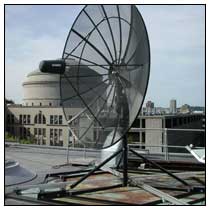|


Measurement of the Doppler spectrum
of interstellar atomic hydrogen and the dynamics
of the galactic rotation. A 2.5-meter computer-controlled
alt-azimuth parabolic dish antenna, located on
a roof of MIT, is used with a heterodyne measurement
chain and digital correlator to observe the Doppler
spectrum of the 21-cm hyperfine line of interstellar
atomic hydrogen in various directions along the
Milky Way. Features of the spiral-arm structure
of the Galaxy are deduced from the measured radial
velocities of the HI clouds in the galactic disc.
Student Wiki: 21-Cm Radio Astrophysics
Download
Lab Guide in PDF format
Live camera: jlab-24.mit.edu
The SRT server daemon should already be running on the computer jlab-24 in 36. If not, contact the staff.
Here are the files necessary to start the SRT user interface from your own computer (right-click and save as):
Here are the Java source files used to create the .jar file (you don't need these unless you're really interested
in how the program works): Download
srt_src.zip
MATLAB Parsers for the .rad files produced by the SRT software.
Parser 1 takes a .rad file and outputs an array of data structures, where each member of the array is a scan. Parser 2 takes a .rad file and outputs a large matrix where each row is a scan.
JAVA Parser for the .rad files; can plot scans and do some limited data analysis.
Previous incarnations of User's Manuals for the SRT. Still useful but some parts may be out of date.
Software Radio. Litster's notes of how the new SRT radio works: SoftwareRadio.pdf (also relevant to the old SRT).
(certificates
required)

Most important references are listed first.
- [1923] H.I. Ewen and E.M. Purcell, "Observation
of a Line in the Galactic Radio Spectrum", Nature, 168, (1923)
- [1981] R. G. Lerner and G. L. Trigg, Encyclopedia of
Physics, (Reading, MA, Addison-Wesley, 1981), "Radio Astronomy", pp. 41-42, Good
introduction to radiometry by Arno Penzias
- Radio Astronomy of the Sun from "Radio Astronomy", 2nd Edition by John D. Kraus: 1986
- Hydrogen Line Emission and Galactic Structure from "Radio Astronomy", 2nd Edition by John D. Kraus: 1986
- [1960] I. Schlovsky, "Cosmic
Radio Waves: Chapter 4", Harvard University Press, pp. 202-270, (1960), Provides a good treatment of the physics of the 21-cm hydrogen line
- [1968] D. Mihalas and J. Binney, Galactic Astronomy,(San Francisco,W.H. Freeman, 1968), "Galactic Rotation and the Spiral Structure of Our Galaxy",Chap. 8
- [1982] F. H. Shu, The Physical Universe, (Mill Valley,
CA, University Science Books, 1982), "Our Galaxy: The Milky Way System",
Chap. 12. This reference gives a clear description of the
interpretation of 21cm spectra in terms of the rotation curve of the
Galaxy.
- Particle Data Group: Astrophysical Constants and Parameters
- [1973] M.A. Tuve and S. Lundsager, "Velocity Structures in Hydrogen Profiles: A Sky Atlas of Neutral Hydrogen Emission", Carnegie Institution ofWashington Publication, no. 630, (1973). The data in Appendix B are particularly useful for verifying the quality of your own data using our much lower resolution SRT.
- [1954] H.C. Van de Hulst, "The Spiral Structure of the Outer Part of the Galactic System Derived from the Hydrogen Emission at 21cm Wave Length", Bulletin of the Astronomical Institutes of the Netherlands, Vol. 12, Number 452, (1954)
- [1969] F. J. Kerr, in "The Large Scale Distribution of Hydrogen in the Galaxy", Annu. Rev. Astro. Astrophys. (1969)
- Download Haystack Radio Telescope User's Manual (pdf)
- Download 2010 Users Manual Supplement

- Google Sky
- Solar Noon Calculator
- NOAA Solar Position Calculator
- Wikipedia Entry on the Milky Way Galaxy
- Cambridge University Press Handbook of Space Astronomy and Astrophysics
- Marshall Space Flight Center - Solar Research
Page
- Excerts from "Radio Astronomy", 2nd Edition by John D. Kraus: 1986
- Antennas
- Recievers
- UC San Diego Center for Astrophysics - Prof. Gene Smith's Milky Way Tutorial
- History
of Radio Astronomy at MIT
Small Radio Telescope Engineering Resources
- Haystack Observatory's SRT Website This is a very
important site for students to investigate. Detailed block diagrams
and schematics of the 21-cm receiver, mount and ground controller are
available there.
An updated technical discussion of the operation of the SRT is available
here (pdf).
- SAMI
Antenna Installation Manual
- Electronic Noise Calibration System for the
SRT (pdf).
There is also a copy of the report
on this computer.
- American Radio
Relay League
- 6.661
Receivers, Antennas, and Signals, Spring 2003
- FCC Radio Spectrum Frequency Allocation Chart
|